

Maya Cohen Levy (born 1955), [1] also known as Maya Cohen-Levy, is an Israeli painter and sculptor.


Maya Cohen Levy (born 1955), [1] also known as Maya Cohen-Levy, is an Israeli painter and sculptor.
Maya Cohen Levy was born in Tel Aviv. She studied philosophy at Tel Aviv University from 1973 to 1974. From 1975 to 1979, she pursued advanced studies at the High School for Art in Tel Aviv. In 1983, she went to Japan to study calligraphy and sumi-e painting.
Heavily pregnant in 1984, she was told by a senior artist in the Kalisher School of Art, "You'll never be an artist now." She said this made her feel terrible, but also strengthened: "We were operating in a male environment, in a culture that believed that the great artists are men. It doesn't matter what your feminist views were, in the end you were left with that. The way to success was to adopt that attitude and not to be a mother. Women who wanted to enter the field had to be like that." [2] In the 1980s, after gaining a stipend to work at a center in the United States, she said that she would attend with her daughter, and was sent rules, which included "no children or pets". [2]
She initially believed that she had to make the choice between motherhood and a career as an artist, but became one of the few women artists at that time who decided that motherhood was compatible with being an artist. [2] Women artists of the previous generation had either chosen not to have children, or left children with others to look after, such as Lea Nikel, whose daughter lived in a kibbutz. [2] Very few women were art school teachers and those who were did not have children. [2]
1994-5, she studied calligraphy in Beijing, China. In 2000, she had an exhibition Ponds 1995-2000, sponsored by The Nelford Foundation, at Tel Aviv Museum of Art. [3] The paintings used the theme of ponds in various forms. [3]
In 2002, she was one of the 10 Israeli artists invited to participate in the first seminar of Ma'aseh Hoshev (Informed Creations), under the auspice of the Schechter Institute for Jewish Studies (SIJS). [4] The aim of the project was to connect Talmudic knowledge with artistic creation. [4] Levy's contribution addressed the Israel-Palestinian conflict with the superimposition of a text from the bible onto the statement made by an arrested Palestinian man. [4]

In 2006, her painting Roots (right) was sold at Sotheby's, whose catalogue notes said:
She had painted other works with the same title 2000–2002. [6]
The characteristic of her work is a complexity of paint streaks, which have used organic images such as the honeycomb, the palm tree and the sunflower, where her discovery of the golden spiral organisation of the plant's seeds led to an exploration of the Islamic tradition, which counterbalanced her initial influence from Abstract Expressionism and resulted in depictions of upside-down trees, whose branches thus appear to be roots. [7]
Her work includes paintings, sculptures, installations and books in collaboration with writers and poets. [1] She has taught for 25 years in schools including Bezalel Art Academy in Jerusalem and the Kalisher Art School in Tel Aviv. [1]
Levy lives in Tel Aviv.
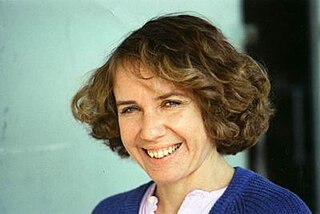
Pamela Levy (1949–2004) was an Israeli artist.

Gideon Gechtman was an Israeli artist and sculptor. His art is most noted for holding a dialogue with death, often in relation with his own biography.

Gabriel Shamir (1909-1992) and Maxim Shamir (1910-1990) were Israeli graphic designers. They designed Israel's official state emblems, medals, stamps and currency notes.

Pinchas Cohen Gan is an Israeli painter and mixed-media artist. He was awarded the Sandberg Prize (1979), the Culture and Sport Ministry's prize for his life's work (2005), and the Israel Prize in Art (2008).

Shy Abady is an Israeli artist. Over the years, Abady created "biographical" series, which followed individual figures .Other series addressed historical-political themes .In some other series,, Abady examines the language of art itself and the aesthetic influences and relationships between Western-Christian art and Jewish-Israeli art. Abady's work has been shown in solo and group exhibitions in many galleries and museums in Israel and abroad.

Nurit Yarden is an Israeli Art photographer, who lives and works in Tel Aviv. She won the Israel Ministry of Culture Prize for the Encouragement of Visual Arts in 2002.

Miri Nishri is an interdisciplinary Israeli artist.

Visual arts in Israel refers to plastic art created first in the region of Palestine, from the later part of the 19th century until 1948 and subsequently in Israel and the occupied Palestinian territories by Israeli artists. Visual art in Israel encompasses a wide spectrum of techniques, styles and themes reflecting a dialogue with Jewish art throughout the ages and attempts to formulate a national identity.
Mirit Cohen was a Russian-born Israeli sculptor and painter. Cohen resided in New York City from 1975. In 1990, she committed suicide.

Khen Shish is an Israeli painter and installation artist.

Miki Kratsman is an Israeli photographer, photojournalist and activist.
Uri Gershuni is an Israeli photographer and educator.
Tami Katz-Freiman, former Chief Curator of the Haifa Museum of Art, is an art historian, curator and critic, based in Miami, Florida, where she works as an independent curator of contemporary art.
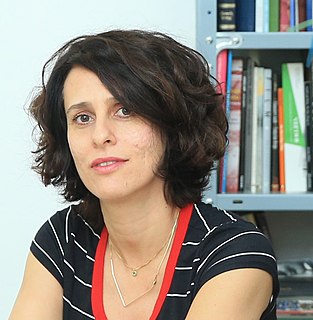
Maya Zack is an artist-filmmaker who creates video art and installations.
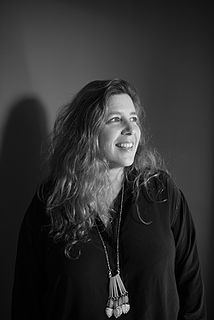
Ayelet Carmi, is an Israeli painter and installation artist.
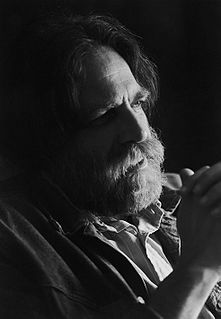
Michael Sgan-Cohen was an Israeli artist, art historian, curator and critic. His oeuvre touches different realms of the Israeli experience and the Hebrew language, displaying a strong connection to the Jewish Scriptures. His works were nurtured by his extensive knowledge of Art history, philosophy, Biblical Texts, Jewish thought and Mysticism, which in turn illuminated all these pursuits. His engagement with Judaism and the Bible as a secular scholar and his vast knowledge of modern and contemporary art contributed to the development of a distinctive approach which combined Jewish and Israeli symbols and images to create a multilayered and contemporary artistic language.

Ruth Schloss was an Israeli painter and illustrator. Major themes in her work were Arabs, transition camps, children and women at eye-level. She expressed an egalitarian, socialist view via realism in her painting and drawing.

Gastón Zvi Ickowicz is an Israeli visual artist living and working in Tel Aviv.
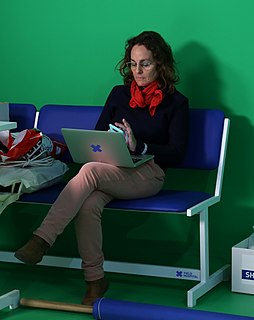
Aya Ben Ron is an Israeli multidisciplinary artist, known for site-specific projects, installations and videos that examine prospects of caregiving and medical ethics. Ben Ron lives and works in Tel Aviv, Israel, and is a professor at The School of the Arts, University of Haifa.

Avi Lubin ; born 1977, is an Israeli curator of contemporary art. As of 2018, he is the curator of Hamidrasha Gallery. Lubin is also the co-founder and co-editor of Tohu Magazine, and the curator of Field Hospital X – Aya Ben Ron's work, which represented Israel at the 58th Venice Biennale, 2019.